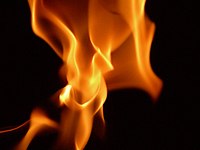
Photo from wikipedia
Abstract Laminar premixed flame front may be wrinkled due to the hydrodynamic and diffusive-thermal instabilities. This may lead to the occurrence of the cellular structure and the self-acceleration. The lean… Click to show full abstract
Abstract Laminar premixed flame front may be wrinkled due to the hydrodynamic and diffusive-thermal instabilities. This may lead to the occurrence of the cellular structure and the self-acceleration. The lean unstable hydrogen/air premixed flame at various initial pressures are studied to clarify the effect of the initial pressure on the evolution of the unstable laminar flame. Linear and nonlinear development stages of the unstable flame are simulated and investigated separately. In the linear stage, the initial sinusoidal wave disturbance on the flame front will still keep its initial configuration. The growth rate increases firstly and then decreases with the increase of the wavenumbers. The effect of the self-acceleration on the unstable flame front will be stronger in the linear stage at the higher initial pressure, since there are larger thermal expansion and constant Lewis number for hydrogen/air premixed flame at higher pressure. There are little discrepancies for the calculated growth rates with those predicted by the revised dispersion relation. The nonlinear stage of the unstable flame propagation could be divided into two stages, the transitional and the stable nonlinear stages. In the transitional stage, the flame front cells splits, merges and moves all the time and the initial wavenumber has a great influence on the cell evolution process. With the evolution of the cell on the flame front, the cellular structure on the flame front will not change greatly with the initial wavenumbers in the stable nonlinear stage. The effect of self-acceleration due to the wrinkling of the flame front at this stage is weakened with the increase of the initial pressure. At the higher pressure, more wrinkled structures with smaller mean curvature are distributed on the flame front. At last, results show that the flame front will propagate faster for the larger computation domain. Based on the fractal theory, the fractal dimension of lean hydrogen/air premixed flame with the equivalence ratio of 0.6 at 0.5 MPa in the 2D domain is obtained and around 1.26.
Journal Title: International Journal of Hydrogen Energy
Year Published: 2019
Link to full text (if available)
Share on Social Media: Sign Up to like & get
recommendations!